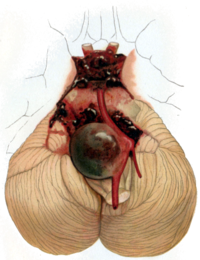
E-049 Dwi infarction patterns and perfusion parameters in anterior versus posterior circulation stroke secondary to intracranial atherosclerotic disease
Sign Up to like & getrecommendations! Published in 2019 at "Journal of NeuroInterventional Surgery"
DOI: 10.1136/neurintsurg-2019-snis.124
Abstract: Purpose Intracranial atherosclerotic disease is a common etiology of ischemic strokes and stroke recurrence. Recent literature suggests treatment should be tailored according to plaque instability versus perfusion failure mechanisms, rather than the degree of stenosis.… read more here.
Keywords: none; posterior circulation; circulation; infarction ... See more keywords

Increased incidence and treatment of intracranial atherosclerotic disease during mechanical thrombectomy is safe, even with an increased number of passes
Sign Up to like & getrecommendations! Published in 2021 at "Journal of NeuroInterventional Surgery"
DOI: 10.1136/neurintsurg-2020-017114
Abstract: Background The incidence of intracranial atherosclerotic disease (ICAD) in acute ischemic stroke treated with mechanical thrombectomy (MT) is not well defined, and its description may lead to improved stroke devices and rates of first pass… read more here.
Keywords: mechanical thrombectomy; intracranial atherosclerotic; disease; icad ... See more keywords

Comment: Antiplatelet Use in Ischemic Stroke
Sign Up to like & getrecommendations! Published in 2022 at "Annals of Pharmacotherapy"
DOI: 10.1177/10600280221096862
Abstract: Kamarova et al1 reviewed antiplatelet agents used in primary and secondary stroke prevention. In their analysis on dual antiplatelet therapy (DAPT) following an acute ischemic stroke, the authors concluded that DAPT for up to 21… read more here.
Keywords: icad; therapy; trial; antiplatelet ... See more keywords

Association of Plaque Morphology With Stroke Mechanism in Patients With Symptomatic Posterior Circulation ICAD
Sign Up to like & getrecommendations! Published in 2022 at "Neurology"
DOI: 10.1212/wnl.0000000000201299
Abstract: Background and Objectives Although the main mechanisms of stroke in patients with intracranial atherosclerotic disease (ICAD)—perforating artery occlusion (PAO) and artery-to-artery embolism (AAE)—have been identified and described, relatively little is known about the morphology of… read more here.
Keywords: icad; morphology; plaque; pao aae ... See more keywords

Imaging of intracranial atherosclerotic plaques using 3.0 T and 7.0 T magnetic resonance imaging-current trends and future perspectives.
Sign Up to like & getrecommendations! Published in 2020 at "Cardiovascular diagnosis and therapy"
DOI: 10.21037/cdt.2020.02.03
Abstract: Intracranial atherosclerotic disease (ICAD) is one of the most common causes of ischemic stroke and carries a relatively high risk of stroke recurrence. Advances in high-resolution magnetic resonance imaging (HRMRI) techniques of intracranial arteries now… read more here.
Keywords: atherosclerotic plaques; intracranial atherosclerotic; resonance imaging; magnetic resonance ... See more keywords

Risk Factors for Asymptomatic and Symptomatic Intracranial Atherosclerosis Determined by Magnetic Resonance Vessel Wall Imaging in Chinese Population: A Case–Control Study
Sign Up to like & getrecommendations! Published in 2022 at "Therapeutics and Clinical Risk Management"
DOI: 10.2147/tcrm.s335401
Abstract: Background and Purpose The association between risk factors and intracranial atherosclerosis disease (ICAD) determined by magnetic resonance (MR) vessel wall imaging in Chinese population has not been investigated. The aim of this study was to… read more here.
Keywords: icad; vessel wall; risk factors; risk ... See more keywords